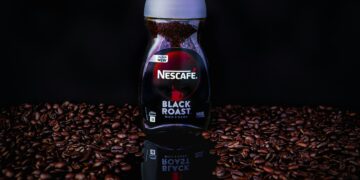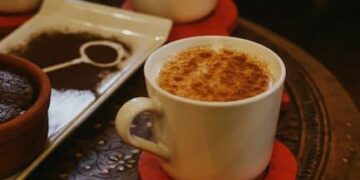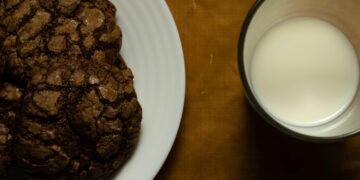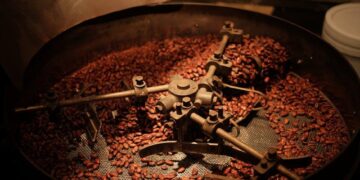Table of Contents
For years, I was trapped in a cycle of caffeinated disappointment.
It started every morning around 10 AM—a craving for a Venti Iced Caffè Latte that no homemade concoction could satisfy.
I’d follow the online recipes, brew what I thought was strong coffee, pour it over ice, add milk, and end up with the same sad result: a thin, insipid, watery ghost of the rich, creamy beverage I was dreaming of.
It was a daily reminder of my failure.
So, I’d sigh, grab my keys, and join the drive-thru line, trading another $7 for the drink I couldn’t seem to master.
That habit cost me over $2,500 a year, but the real cost was the frustration of knowing there had to be a better Way.1
This guide is the story of how I broke that cycle.
It’s the result of a quest that led me away from coffee blogs and into the unexpected world of thermodynamics and craft cocktail mixology.
I discovered that a perfect iced latte isn’t about a secret recipe; it’s about understanding a system.
It’s about managing temperature, controlling dilution, and building texture with intention.
By the end of this deep dive, you will have more than just a recipe.
You will have a complete blueprint for creating a Venti Iced Latte at home that is not just as good as the one from the café, but consistently better.
You will understand the science behind every step, empowering you to ditch the drive-thru for good and become the master of your own home café.
In a Nutshell: The 4 Commandments of the Un-Watery Iced Latte
For those who want the solution without the story, here is the core philosophy:
- Forge a Bulletproof Foundation: Your espresso must be brewed stronger than you would for a hot drink. A standard shot is not enough to survive the dilution from milk and ice. Use 3 shots of fresh, high-quality espresso for a Venti-sized (24 oz) drink.2
- Execute the Chill Protocol: Never pour hot espresso directly over ice. This is the cardinal sin that creates a bitter, watery mess.5 Instead, chill the espresso
first using a low-dilution method like a cocktail shaker or an ice bath.2 - Engineer Your Ice: Ice is an ingredient, not an afterthought. Use the largest, densest ice cubes you can make. Large cubes have less surface area and melt slower, providing maximum chilling with minimum dilution.8 Fill your glass to the brim.
- Build for Body: The creaminess of your latte is determined by milk fat. Use whole milk or a “barista blend” oat milk for a rich, velvety texture that resists the perception of wateriness. Skim milk is the enemy of a creamy iced latte.10
Part I: The Anatomy of Disappointment: Why Most Homemade Iced Lattes Are Doomed from the Start
Before we can build the perfect iced latte, we must perform a forensic analysis of the common failures.
For me, this was a painful but necessary process of dissecting my own watery creations to understand where I was going wrong.
It turns out, the “standard advice” often sets you up for failure by ignoring the fundamental physics of a chilled beverage.
The Cardinal Sin: Pouring Hot Espresso Directly on Ice
This is the most common and catastrophic mistake.
In countless online forums, home baristas lament that their ice melts instantly, leaving them with a diluted drink.12
The advice to simply pour hot coffee over ice is fundamentally flawed.
When a shot of espresso, brewed at around
195∘F to 205∘F (90∘C to 96∘C), hits ice at 32∘F (0∘C), the massive temperature difference creates an incredibly rapid and violent heat transfer.14
This thermal shock does two terrible things simultaneously.
First, it causes immediate, massive dilution.
The hot liquid dumps a huge amount of energy into the ice, causing it to melt at an alarming rate.
One barista forum contributor noted that this method will “definitely get a far waterier drink”.16
You’re not just cooling your coffee; you’re flooding it with water from the very first second.
Second, this shock can “scorch” the espresso.
Baristas have observed that this sudden temperature change can create a bitter, watery, and over-extracted taste.5
The delicate, volatile aromatic compounds that give fresh espresso its life are damaged or boiled off by the extreme temperature gradient.
The problem isn’t your ingredients; it’s a failure of thermal management.
You’ve created an uncontrolled collision of temperatures, and your coffee’s flavor is the casualty.
The Weak Foundation: The “Strong Coffee” Myth and Stale Shots
Many recipes vaguely call for “strong coffee,” but this advice is dangerously imprecise.
An iced latte’s foundation must be specifically engineered to survive the hostile environment of milk and melting i.e. A standard-strength coffee, even a perfectly pulled espresso shot, is not designed to withstand this double dilution.
It’s like building a house to normal code in a hurricane zone; it’s destined to be washed away.
The solution is not just “strong coffee” but a concentrated espresso base.
Experts recommend “double brewing” or using a higher coffee-to-water ratio to create a base that is intentionally too strong on its own.2
This way, after being diluted by milk and a controlled amount of ice melt, it arrives at the perfect, robust flavor.
Furthermore, the type and freshness of this foundation are non-negotiable.
Using strongly-brewed drip coffee or a Moka pot might seem like a good substitute, but it lacks the essential oils and concentrated body of true espresso, leading to a “one-dimensional flavor”.3
Even worse is using pre-pulled espresso shots that have been chilled in the fridge.
While this seems like a clever way to avoid the hot-on-ice problem, it’s a critical error.
Chilled, old espresso loses its “robust, bittersweet depth” as its essential, aroma-harboring oils oxidize, resulting in a stale, acidic, and lifeless drink.3
The only way to build a worthy foundation is with freshly pulled, high-quality espresso shots for every single drink.
The Sweetener Sandtrap and the Milk Mismatch
Even if you manage your espresso and ice perfectly, two final traps can ruin your drink’s texture, creating a perceived wateriness that is just as disappointing as the real thing.
The first is the sweetener sandtrap.
Adding granulated sugar or even raw sugar to a cold latte is a recipe for a gritty, unpleasant texture.
The sugar simply won’t dissolve in the cold liquid.2
The professional technique is to use a liquid sweetener, like a simple syrup, and to dissolve it into the espresso while it is still hot.16
This ensures seamless integration and a perfectly smooth drink.
The second, and more crucial, issue is the milk mismatch.
The rich, creamy body of a café-quality latte comes from fat.
A general rule in coffee is that the more fat in the milk, the richer and creamier the final drink will be.10
Whole milk, with a fat content of around 3-4%, achieves an ideal balance of taste and texture.
When you opt for reduced-fat (1-2%) or skim milk, you lose that essential fat content.
The result is a beverage that feels “weak and watery,” even if the actual water content is low.10
Your brain perceives the thin texture and interprets it as dilution.
To win the war against the watery latte, you must fight on two fronts: one against unwanted water from ice, and another against the thin, unsatisfying texture of low-fat milk.
Part II: The Mixologist’s Epiphany: How Thinking Like a Bartender Revolutionized My Coffee
My journey out of the watery abyss began not in a coffee shop, but while watching a bartender craft a perfect Old Fashioned.
I watched them use a single, massive, crystal-clear cube of i.e. They treated the ice not as a cooler, but as a critical ingredient.
They understood its properties, its melt rate, and its effect on the final drink.
That was my “aha!” moment.
I realized an iced latte is not a hot coffee that has been cooled.
It is a chilled, multi-ingredient beverage, and the undisputed masters of that domain are not baristas, but bartenders and mixologists.
The Central Analogy: The Science of Cocktail Ice
The principles that govern a world-class cocktail are the exact same principles that govern a world-class iced latte.
In mixology, ice is a tool used to control two things: temperature and dilution.9
An Old Fashioned is a spirit-forward cocktail; the goal is to chill the whiskey while adding just enough water to open up its complex flavors, without turning it into a watery mess.
A bartender achieves this with a large, dense ice cube because its low surface-area-to-volume ratio means it melts slowly, providing sustained chilling with minimal dilution.8
An iced latte is an espresso-forward beverage.
Our goal is identical: chill the espresso and milk with controlled dilution to create a refreshing drink that still tastes powerfully of coffee.
The enemy in both scenarios is uncontrolled dilution from fast-melting i.e. By reframing the iced latte as a “cocktail” with espresso as its “spirit,” we can import the entire scientific toolkit of mixology.
We stop thinking about “cooling coffee” and start thinking about “building a balanced, chilled beverage.” This simple shift in perspective changes everything.
It forces us to prioritize variables like ice quality and chilling methods that are almost completely ignored in the world of home coffee making.
The Physics of Chilling: It’s All About the Melt
This new framework led me to a crucial, counter-intuitive scientific principle: the primary chilling power of ice comes not from its inherent “coldness,” but from the act of melting.
The phase transition from solid ice to liquid water requires an enormous amount of energy, which is known as the latent heat of fusion.
Ice “steals” this energy from the surrounding liquid, thus cooling it down.
In fact, it takes about 80 times more energy to melt one gram of ice than it does to raise the temperature of that same gram of ice by one degree Celsius.20
What this means is that chilling your drink with ice without causing any dilution is a physical impossibility.
Some ice must melt to lower the temperature of your latte.
This realization is liberating.
It frees us from the impossible goal of “zero dilution” and gives us a new, achievable mission: managing the dilution.
We must accept that some water will be added and prepare for it by overbuilding our espresso foundation (Pillar 1) and using high-quality ice that gives us the most chilling power for the least amount of water (Pillar 3).
Dilution is not the enemy; uncontrolled dilution Is.
Part III: The Un-Watery Blueprint: The Four Pillars of a Perfect Iced Latte
Armed with the mindset of a mixologist, I developed a new system for building my iced lattes, based on four essential pillars.
This is the blueprint that finally ended my cycle of failure and will do the same for you.
Pillar 1: Espresso Integrity – Forging a Bulletproof Foundation
The quality of your final drink is almost entirely predicted by the quality of its foundation.
This pillar is about creating an espresso shot that is strong enough and flavorful enough to be the undeniable star of the show.
- Use Fresh, Quality Beans: This is non-negotiable. Start with fresh, whole-bean coffee and grind it immediately before brewing to preserve its volatile aromatic compounds.14 For a classic, rich latte flavor, an “espresso roast” is an excellent choice, often featuring notes of molasses and caramelized sugar that pair beautifully with milk.3
- Brew for Strength: As established, you must brew a more concentrated shot than you would for a hot drink to counteract the inevitable dilution. For a Venti-sized (24 oz) latte, the standard two shots are insufficient. A baseline of three espresso shots is required. This ensures that after adding milk and accounting for ice melt, the drink still has a robust coffee character.2
- Dial In Your Extraction: The perfect shot is a balance. Ensure your machine’s water temperature is in the optimal range of 195∘F to 205∘F (90∘C to 96∘C).13 Your grind must be fine enough to allow for proper extraction—too coarse and your shot will be under-extracted and taste sour and watery; too fine and it will be over-extracted and bitter.4
- Use Good Water: Coffee is over 98% water. If your tap water has any off-tastes like chlorine, it will taint your coffee. Using properly filtered water is a simple step that makes a palpable difference in the final cup.2
Pillar 2: The Chill Protocol – Mastering Temperature Without Sacrificing Flavor
This pillar directly addresses the cardinal sin of pouring hot espresso on ice. The goal is to rapidly cool the espresso before it is integrated into the final drink, using a method that introduces as little dilution as possible.
| Method | Dilution Level | Speed | Equipment Needed | Best For |
| Cocktail Shaker 2 | Low-Medium | < 30 seconds | Cocktail Shaker, Ice | Speed, aeration, and creating a foamy texture. |
| Ice Bath 7 | Very Low | ~ 60 seconds | Metal Cup, Larger Bowl, Ice, Water | Purity of flavor with minimal dilution and no special gadgets. |
| Pre-Chilled Vessel 26 | Very Low | ~ 60 seconds | Freezer, Metal Pitcher or Thick Glass | Excellent low-tech method; the cold vessel acts as a heat sink. |
| Hyperchiller 12 | Near-Zero | ~ 60 seconds | Hyperchiller Device | Gadget lovers who want the absolute lowest dilution possible. |
| Coffee Ice Cubes 2 | Zero / Negative | N/A (Prep) | Ice Cube Tray | The perfectionist; as the cubes melt, they add more coffee flavor. |
| Direct Pour on Ice (The “Don’t”) | Catastrophic | Instant | Glass, Ice | Ruining your coffee. |
Pillar 3: Ice Architecture – Your Drink’s Most Important (and Overlooked) Ingredient
Welcome to the core lesson from the world of mixology.
Ice is an active ingredient that must be engineered for performance.
- Go Big: The single most impactful change you can make is to use the largest ice cubes your freezer can produce. Large cubes have a significantly lower surface-area-to-volume ratio compared to small or crushed ice. This means they melt much, much slower, providing sustained chilling with drastically less dilution.1 Stop using the ice from your refrigerator’s automatic dispenser; invest in large silicone molds for 2-inch cubes or spheres.
- Aim for Clarity: While not strictly necessary, creating clear ice takes your drink to the next level. Cloudy ice is filled with trapped air bubbles and impurities, which cause it to be less dense and melt faster. Clear ice is purer, denser, and melts more slowly, further reducing dilution.8 This can be achieved through methods like directional freezing.
- Use Plenty of It: Don’t be shy with your high-quality ice. Fill your serving glass completely to the brim. A larger thermal mass of ice will chill the incoming liquid more rapidly and, counter-intuitively, the overall melt rate will be slower than if you had used only a few cubes swimming in warm liquid.1
Pillar 4: The Body Builder – Milk’s Role in Texture and Flavor
This final pillar tackles the problem of “perceived wateriness” by focusing on the crucial role of milk fat in creating a rich, satisfying texture.
| Milk Type | Typical Fat % | Creaminess / Mouthfeel | Flavor Contribution | Textural Dilution Resistance |
| Whole Dairy Milk 10 | ~3.5% | Rich, Velvety, Creamy | Naturally Sweet, Creamy | High |
| 2% Dairy Milk (Starbucks Standard) 30 | ~2% | Balanced, Smooth | Neutral | Medium |
| Skim Dairy Milk 18 | <0.5% | Thin, Watery | Watery | Low |
| Oat Milk (Barista Blend) 31 | ~3-5% | Very Creamy, Silky | Neutral to Sweet, Malty | High |
| Oat Milk (Regular) 32 | ~1-2% | Moderate Creaminess | Distinctly Oaty | Medium-Low |
| Almond Milk 11 | ~1% | Thin | Noticeably Nutty | Low |
| Soy Milk 33 | ~2% | Moderate, Can be Creamy | Beany, Neutral | Medium |
For a truly decadent and creamy iced latte that mimics the best café versions, whole milk or a high-fat barista blend oat milk are the superior choices.
Their higher fat content provides the luxurious mouthfeel that makes the drink feel substantial and robust, effectively fighting off any perception of being watery.
Part IV: The Assembly Line: Building the Venti Iced Caffè Latte, Step-by-Step
Now, we bring the four pillars together into a single, foolproof workflow.
This is the assembly line for the perfect Venti Iced Caffè Latte.
Step 1: Mise en Place – Prepare for Success
Before you pull your first shot, prepare your station like a professional.
Get out your chilled 24 oz glass, your espresso machine, freshly ground coffee, your chosen milk (straight from the fridge—cold milk is key) 34, your large, high-quality ice, and any liquid sweetener.
Pre-chilling your serving glass in the freezer is a pro move that provides an initial stage of cooling.26
Step 2: The Brew & Sweeten – Forge the Foundation
Execute Pillar 1.
Brew a strong triple shot of espresso.
If you desire a sweetened latte, this is the moment to add your liquid sweetener.
Add it directly to the hot espresso in your shot glass or pitcher and stir until it is completely dissolved.
This ensures perfect, grit-free integration.16
Step 3: The Chill – Execute the Protocol
Immediately after brewing and sweetening, it’s time for Pillar 2.
Chill your espresso using your preferred low-dilution method from the table above.
If using a cocktail shaker, add the hot espresso and a few cubes of ice to the shaker, seal it, and shake vigorously for 10-15 seconds until the outside is frosty.
If using an ice bath, place your metal cup of espresso into the bowl of ice water and stir until cool.
The goal is to bring the temperature down as quickly as possible.
Step 4: The Build – The Definitive Order of Operations
This is the final assembly, where we combine our components in the optimal order to minimize ice melt.
This method is based on the principle of sequential temperature reduction.
- Ice the Glass: Take your pre-chilled 24 oz serving glass and execute Pillar 3. Fill it completely to the brim with your large, high-quality ice cubes.
- Combine Liquids: In a separate vessel (a milk pitcher or another glass), combine your chilled espresso from Step 3 with about 12-16 oz of cold milk (Pillar 4). Give this mixture a quick swirl. By combining the two liquids first, you create a larger volume of cold liquid at an intermediate temperature, rather than introducing small pockets of relatively warmer liquid to the ice.
- Pour and Serve: Pour the combined, tempered espresso-milk mixture over the ice in your serving glass. The liquid hitting the ice will already be cold, dramatically slowing the final rate of melt and preserving the integrity of both your ice and your drink’s flavor.15
Step 5: The Finish – Enjoy Your Mastery
Give the final drink a gentle stir with a long spoon to ensure everything is perfectly blended.
Take a sip.
That is the taste of victory—a rich, creamy, robustly flavorful, and perfectly chilled iced latte.
It is not watery.
It is not a disappointment.
It is perfection, crafted by your own hands.
Conclusion: Your Home Café, Perfected
My journey began with a simple, frustrating problem: a watery homemade iced latte and a costly daily habit.
The solution, I discovered, was not in a secret Starbucks recipe, but in a fundamental shift in thinking.
By looking to the meticulous science of craft mixology, I learned to see my iced latte not as a coffee, but as a cocktail.
This new perspective taught me to respect the ingredients—especially the i.e. It taught me to manage temperature with the precision of a physicist and to build texture with the intention of a chef.
The four pillars—Espresso Integrity, the Chill Protocol, Ice Architecture, and the Body Builder—are the foundation of this new approach.
They transform the act of making an iced latte from a game of chance into a repeatable science.
The victory here is not just financial, though breaking free from a $2,500-a-year habit is certainly a welcome outcome.1
The real victory is in the mastery of a craft.
It is the deep satisfaction that comes from understanding the “why” behind every step and using that knowledge to create something truly excellent, time and time again.
You are no longer just a consumer; you are an empowered creator, the master of your own home café.
The quest is over.
Works cited
- These iced coffee mistakes left me with watery lattes at home for years – here’s how I invested in a better set-up, accessed August 3, 2025, https://www.idealhome.co.uk/all-rooms/coffee/iced-coffee-mistakes-and-how-to-fix-them
- Ways You’re Messing Up Your Iced Coffee – Mashed, accessed August 3, 2025, https://www.mashed.com/69278/ways-youre-messing-iced-coffee/
- The Mistake To Avoid When Making A True Iced Latte At Home – Tasting Table, accessed August 3, 2025, https://www.tastingtable.com/1655665/mistake-homemade-iced-latte-espresso/
- Why Does My Iced Coffee Taste Watery? Root Causes & Fixes, accessed August 3, 2025, https://majestycoffee.com/blogs/posts/why-does-my-iced-coffee-taste-watery
- Video: Barista says you’ve been making iced lattes wrong your whole life – The Manual, accessed August 3, 2025, https://www.themanual.com/food-and-drink/how-to-make-a-better-iced-latte/
- For A Better Iced Latte, Pour Your Milk First – Tasting Table, accessed August 3, 2025, https://www.tastingtable.com/1610603/make-better-iced-latte-tip/
- outin.com, accessed August 3, 2025, https://outin.com/blogs/news/iced-espresso-summer-recipes#:~:text=Chill%20Your%20Espresso%20Without%20Watering%20It%20Down&text=Quick%20Ice%20Bath%3A%20Pour%20espresso,regular%20ice%20for%20undiluted%20flavor.
- The Science of Cocktail Ice – Bare Barrel, accessed August 3, 2025, https://www.barebarrel.com/blogs/the-bare-barrel-blog/the-science-of-cocktail-ice
- Science Behind the Perfect Ice – Alchemy Bartending School, accessed August 3, 2025, https://alchemybar.com/science-behind-the-perfect-ice/
- Which Kind of Milk Should You Choose for Coffee? – Urnex, accessed August 3, 2025, https://urnex.com/blog/which-kind-of-milk-should-you-choose-for-coffee
- Is There a Right Choice When it Comes to Milk? – Vantage Coffee Roasters, accessed August 3, 2025, https://vantagecoffeeroasters.com/blogs/sip-tell/is-there-a-right-choice-when-it-comes-to-milk
- Iced Latte keeps ending up super watery? : r/nespresso – Reddit, accessed August 3, 2025, https://www.reddit.com/r/nespresso/comments/1bmivtu/iced_latte_keeps_ending_up_super_watery/
- how to make iced drinks that aren’t watered down – desperate new manager here : r/Coffee, accessed August 3, 2025, https://www.reddit.com/r/Coffee/comments/bxaloq/how_to_make_iced_drinks_that_arent_watered_down/
- 5 Iced Coffee Mistakes You’re Probably Making, According to a Master Barista – EatingWell, accessed August 3, 2025, https://www.eatingwell.com/article/7836007/iced-coffee-mistakes-youre-probably-making-according-to-a-master-barista/
- does the order you combine ice/coffee/milk matter? : r/AskPhysics – Reddit, accessed August 3, 2025, https://www.reddit.com/r/AskPhysics/comments/i45hbs/iced_coffee_conundrum_does_the_order_you_combine/
- What’s the best way to make an iced latte? – Barista Exchange, accessed August 3, 2025, https://www.baristaexchange.com/forum/topics/whats-the-best-way-to-make-an
- Don’t make THIS mistake when making iced lattes – YouTube, accessed August 3, 2025, https://www.youtube.com/shorts/fsRR6QtVZl4
- What is the best type of milk for iced coffee? – Cold Brew Guru, accessed August 3, 2025, https://coldbrewguru.com.au/what-is-the-best-type-of-milk-for-iced-coffee/
- Why Ice in Your Cocktail Matters More Than You Think – The Tasting Alliance, accessed August 3, 2025, https://thetastingalliance.com/why-ice-matters-more-than-you-think-in-cocktails/
- Ice and Dilution- What is and isn’t myth? : r/cocktails – Reddit, accessed August 3, 2025, https://www.reddit.com/r/cocktails/comments/9fau6y/ice_and_dilution_what_is_and_isnt_myth/
- Ice and Dilution in Shaken Cocktails – Perlage Systems, accessed August 3, 2025, https://perlagesystems.com/blogs/cocktail-blog/ice-and-dilution-in-shaken-cocktails
- Caffè Latte Recipe | Starbucks®️ Coffee at Home, accessed August 3, 2025, https://athome.starbucks.com/recipe/caffe-latte
- Seven Homemade Summertime Coffee Drinks Made with Espresso – OutIn, accessed August 3, 2025, https://outin.com/blogs/news/iced-espresso-summer-recipes
- Espresso-based iced coffee drinks to make at home – Brewing With Dani, accessed August 3, 2025, https://www.brewingwithdani.com/blog/espresso-based-iced-coffee-drinks-to-make-at-home
- How to Cool Coffee Fast – 10 Lightning-Fast Hacks (2025) – Kimbo Coffee, accessed August 3, 2025, https://www.kimbocoffee.com/blogs/kimbo-blog/10-lightning-fast-hacks-to-cool-your-coffee-in-60-seconds-which-will-you-try-today
- How to Make an Iced Espresso – CoffeeGeek, accessed August 3, 2025, https://coffeegeek.com/guides/howtos/iced-espresso-how-to/
- Best way to make iced latte? : r/espresso – Reddit, accessed August 3, 2025, https://www.reddit.com/r/espresso/comments/14la72t/best_way_to_make_iced_latte/
- FIRST FOR WOMEN: 3 Easy Ways to Make Non-Watery Iced Coffee At Home – TAKEYA, accessed August 3, 2025, https://takeyausa.com/blogs/press/first-for-women-3-easy-ways-to-make-non-watery-iced-coffee-at-home
- Let’s Talk Iced Coffee: Savor or Dilute? – craftklaris, accessed August 3, 2025, https://craftklaris.com/blogs/klaris-labs/lets-talk-iced-coffee-savor-or-dilute
- Iced Caffè Latte: Starbucks Coffee Company, accessed August 3, 2025, https://www.starbucks.com/menu/product/407/iced
- Barista edition vs full fat? I’m so confused! – Reddit, accessed August 3, 2025, https://www.reddit.com/r/barista/comments/1aoqowo/barista_edition_vs_full_fat_im_so_confused/
- Exploring Milk Options to Pair with Your Coffee, accessed August 3, 2025, https://thelittlecoffeebagco.com/blogs/news/exploring-milk-options-to-pair-with-your-coffee
- Which milk is best for making coffee? : r/veganrecipes – Reddit, accessed August 3, 2025, https://www.reddit.com/r/veganrecipes/comments/1bin1fq/which_milk_is_best_for_making_coffee/
- How to Achieve the Perfect Milk Temperature for Coffee Drinks, accessed August 3, 2025, https://ravecoffee.co.uk/blogs/news/how-to-achieve-the-perfect-milk-temperature-for-coffee-drinks






